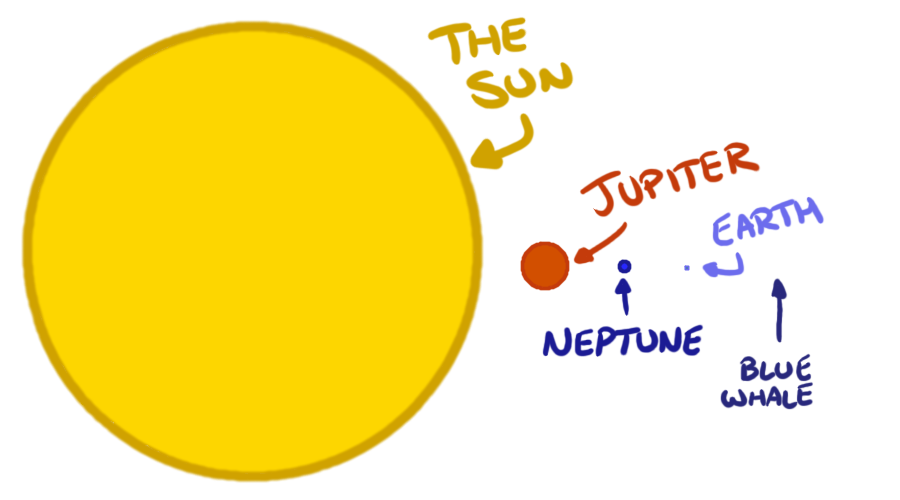 All These Other Planets
All These Other Planets
For a long time (well, relatively) astronomers believed they had this whole "solar system" thing figured out. They had this theory which governed its formation, called the "core-accretion theory," which described stellar and planetary formation. Basically, as all the dust and gasses that make up a star star coalescing into a star, they also begin spinning. As they spin faster, the gasses condense into a kind of spinning disk which is thicker at the center (like spinning our a blob of pizza dough, but a lot more complicated). Finally, this central mass gets hot and dense enough to trigger fusion, and the proto-star becomes a real star. Around this time, as the star is finishing its formation, the heavier elements in the spinning disk start clumping together, with the denser elements forming the smaller, rocky planets we see as the "inner planets" in our solar system, and lighter elements and compounds forming gas giants further out. Finally, solar wind blows away the remaining gasses and dust off nearly into the interstellar medium, and the hot planets begin cooling. This theory should also apply to all other solar systems' formations, so other systems should look similar to ours. At least, this is what astronomers reasoned at the time (the time being pre-1990's). But they were wrong. So very wrong.

Pictured: how wrong astronomers were.
When we started actually detecting exoplanets (planets that aren't part of our solar system, short for Extra-Solar Planets), we noticed that none of them seemed to make any sense. There were gas giants bigger than Jupiter orbiting their stars at less than the orbit of Mercury (so-called "Hot Jupiters". There were "Super-Earths," rocky planets more than twice the size of Earth, also orbiting places they shouldn't. The first exoplanet discovered (in a rather certain sense) was half the size of Jupiter and orbited its star at 10% of the orbit of Mercury. But let's back up a minute and ignore the glaring problems with the core-accretion model: how do we even discover exoplanets?
Compared to stars, planets, even those the size of Jupiter, are really, really small.

Pictured: Small
Finding stars in the night sky is sometimes hard enough (I live in a city, there's a lot of light pollution), but the problem with trying to directly look at planets orbiting other stars is twofold. First, they don't emit light. They're not radiant. Any light that comes from them is simply reflected glory from their star (or stars—we've found planets orbiting binary star systems). This makes them much harder to see than stars, because, as you might know, we need light to see something. Second, exoplanets' little light they do shed via reflection is all but drowned out by the much larger amount of light their star(s) is(are) shedding. If we look really, really closely and carefully with modern equipment, we can sometimes directly see an exoplanet or two by its reflected light, but the primary means of exoplanet detection fall into two categories: transit and radial velocity detection.
Radial velocity detection of exoplanets was, until rather recently, the best way of detecting exoplanets (then we got better telescopes, but I'll cover that soon). It boils down to a rather simple idea: gravity. That is, while a star exerts a gravitational force on a planet, so to does a planet exert a gravitational force on a star. The bigger the planet, the bigger the force, as we know from this formula:

We also know that planets orbit their star(s). So, as they orbit, the force exerted on and by the star from gravity is changing direction, pulling the star one way during one point in the orbit, and the opposite direction at another point. This will cause the star to wobble (this method of detection is often referred to as the "wobble method"). If you have a good enough telescope, you can look for that very slight wobble, and infer the existence of an orbiting body. But this method of detection has been eclipsed more recently by one that tends to give us much more information, and that is the transit method of exoplanet detection.
During some point in an exoplanet's orbit, it's going to be sitting precisely between its star and us. Now, because exoplanets are very, very small (see above), this doesn't seem like it would be all that helpful. But, if we have good enough detection equipment (read: telescopes), we can totally notice the dip in light levels from the star when the planet passes in front of it. With this method giving us the size of the planet, we can use the good old wobble method to determine the mass, and get the planet's density, which tells us a whole host of information about it (like if it's a nice, dense rocky planet akin to our own home, or a lightweight like Neptune). Also determined by the transit method is the atmosphere of the planet (if it has one). See, a planet's atmosphere doesn't just blindly let through every wavelength of light in the EM spectrum (our own stops all sort of stuff outside of the visible spectrum, and it tends to scatter a lot more blue light than the rest of the visible spectrum), so we can look at the EM signature of the star before, during, and after the transit of an exoplanet and see what changes to determine what sort of atmosphere it may have. Which is way cool, because the atmosphere of an exoplanet is a microscopically thin line surrounding a dust speck of a dot orbiting a pinpoint of light hundreds of trillions (or more) miles away from us.
So astronomers discovered themselves into a corner with this whole "core-accretion theory" thing, and they haven't been able to theorize themselves out of it yet. The exoplanet hunt has a fairly recent advent, only really getting underway this century, and there's just so much new data pouring in constantly that it's hard to formulate anything solid. What we do know so far is that our own solar system is definitely not the standard template for all planetary systems. We don't really know how strange it may be compared to the average, because, as I've said several times now, planets are really, really small, and the kinds of planets that we have as our inner ones—small, rocky planets—are really hard to detect. But that's not for lack of trying.
The exoplanet hunt keeps picking up, using both satellite telescopes (namely Kepler) and ground-based ones like the Nordic Optical Telescope in the Canary Islands. Just last year, more than 800 new exoplanets were discovered—over six times the discoveries from previous years. And there are some really neat planets out there.
Gliese 1214 b orbits a red dwarf star (Gliese 1214, about 47 light-years away from us) and is in the class of planets astronomers call "Super-Earths." These are small-ish, rocky planets which are much bigger than earth, but still not as big as smaller gas giants. Gliese 1214 b happens to be about six times the size of Earth, and orbits way too close to its parent star (about 1% of Earth's orbital distance). Because of this, its temperatures average around 280°C (540°F), and it has an atmosphere with water in it. Obviously, at those surface temperatures, there's no way liquid water could exist, and what does exist in its atmosphere is even cooler: a water plasma. The planet also does not appear to have a solid surface, and the plasma water would transition seamlessly to steam as you move further out, making it an entirely new type of planet.
55 Cancri e is another Super-Earth that is only twice Earth's size. The catch? It's made up of a lot of carbon and is eight times Earth's mass. This very heavily hints toward it being diamond-rich, or even having a crust analog that is mainly diamond. It's like a science-fiction idea (such as the more-limited Mount Zeus coming from the core of Jupiter). And it's a planet mainly composed of carbon, which is another game-changer. We just keep discovering weird and totally awesome planets out there.
Unfortunately, it's hard to discover other "Earth's," planets which would be habitable to us, because, to reiterate, they're really, really small. But we're always looking, and until someone breaks the known laws of physics and invents faster-than-light travel, looking is what we'll have to settle for, because they're all seriously far away, and space is seriously big. There's just so much out there to find, and every day it seems we discover something strange and new that we never thought could exist. Which is one of the coolest things in science.
